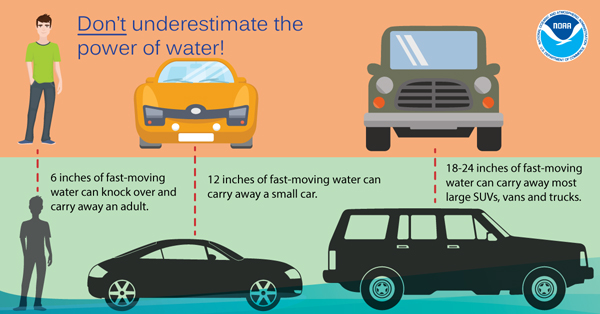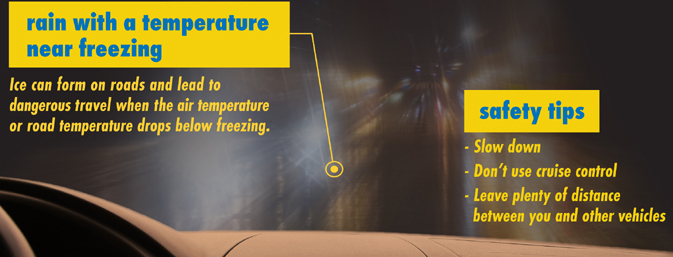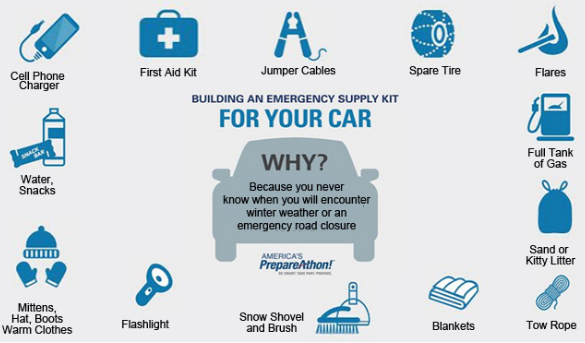This page includes info about driving in fog, on black ice, driving in rain, floods (don’t) and chain requirements, with lots of links to follow.
Prepare for winter driving has tips for using tire chains, tricks for dealing with frozen car locks, how to prepare your vehicle for winter driving, a winter survival kit for your car, what to do if you get stranded, how to keep windows from fogging up and tips for driving in snow and ice.
In the San Jose Mercury News there is a column called “Roadshow” by Gary Richards. From his column:
Reminders for safe navigation of roads as rain and fog arrive
The terrible 198-vehicle pileup on the foggy Long Beach Freeway on Sunday and the promise of rain here later this week are reminders that when the weather changes, we need to alter our driving habits. So here is Roadshow’s annual tips on driving in the fog and rain:
• No. 1: Sl-o-o-o-o-o-w down.
• No. 2: In thick fog, drive with lights on low beam, reduce speed and crack open your window and listen for traffic you cannot see. Never drive with just your parking or fog lights on.
• No. 3: If you are on Interstate 5, look for reflective dots on the right shoulder when approaching an exit. Three side-by-side dots will appear three-tenths of a mile from an exit. At two-tenths of a mile, two dots will appear and at one-tenth of a mile one dot will appear.
• No. 4: Watch electronic warning signs. When visibility is less than 100 feet, Caltrans will flash “Dense Fog Ahead” messages.
• No. 5: When visibility is less than 500 feet, Highway Patrol cars will turn on their flashing lights and lead traffic at a safe pace through major roads between Kern and San Joaquin counties.
• No. 6: If an accident occurs or your vehicle stalls, pull as far off the road as possible, turn on flashing emergency lights, set out flares, and move to a safe area, preferably behind a guardrail. If there is no safe place next to the road, stay in your car and remain buckled up.
• No. 7: S-l-o-o-w down. Driving too fast is the No. 1 cause of accidents on wet days.
• No. 8: Know how to defrost your car. Before turning on the defroster and blower, move the heat control to “hot” and allow the engine to warm up first. If the windshield starts to fog on the inside, open a side window slightly and turn the defroster to a higher speed. If you have an air conditioner, use it to reduce humidity and moisture collecting on the window.
• No. 9: If your car has anti-lock brakes and goes into a skid, you may feel a vibration when pressing the brake pedal. Don’t panic. Hold the brake pedal down firmly. Sensors in anti-lock brakes are adjusting to the wet road, which is why the pedal vibrates. Nothing is wrong, as long as you hold the brake down. Don’t pump or lift your foot off the pedal.
• No. 10: Drive in the tire prints of the car ahead of you. When a car hydroplanes, it’s riding on a thin layer of water between the tires and the road. The water in tire prints has already been displaced, so you get better traction.
• No. 11: If your car hydroplanes, hold the steering wheel steady and lightly apply brakes. When you feel the tires touch the pavement, slow until regaining control.
• No. 12: Don’t speed through standing water.
• No. 13: For motorcyclists, crosswalk lines and pavement arrows are super-slick. Ease up on the throttle on takeoff. And Botts Dots, the raised bumps that separate lanes, are also slippery, so limit lane-splitting.
• No. 14: Check tires and wipers. Traffic police say many drivers in accidents say they couldn’t see because their wipers smeared their windshields on a rainy day.
• No. 15: Keep a safe distance between you and the vehicle in front. Your braking distance is greatly increased in wet driving.
• No. 16: Don’t brake while in a curve if at all possible. Brake before entering the curve.
• No. 17: Use turn signals for all lane changes and turns well in advance so it does not surprise another driver and cause him to brake.
• No. 18: Don’t change lanes.
• No. 19: Dark traffic signals or blinking red lights mean everyone must stop.
• No. 20: You know the drill. S-l-o-o-w down.
– – – – – – – – – – – – – – – – – – – – – – – – – – – – – – – – – – – – – – – – – – – – – – – – – – – – – – – – – –
More on the dots in No. 3 above: these are clear one-way reflective pavement markers on the right shoulder. The first three dots are about 2,100 feet in advance of an exit, the set of two markers are about 1,400 feet before an exit and the last single dot is about 700 feet from the ramp.
__________________________________
And from another roadshow column near the time of the first rain storm of winter:
…The Highway Patrol has more tips on driving in the rain, especially since the dry fall has allowed dirt, leaves, oils, grease and grime to build up on roads, which can cause slippery conditions:
• Regularly clean wipers with a damp cloth to remove oils and debris.
• Clean windows, outside and inside.
• Make sure that headlights and taillights are working and lenses are clean.
• Make sure tires have sufficient tread and are properly inflated. Underinflated tires can lead to hydroplaning.
• Don’t tailgate.
• If the steering feels light, gently ease off the accelerator and allow the car to slow. Don’t abruptly hit the brakes.
• If in a skid, do not brake heavily, jerk the steering wheel or panic. Turn your steering wheel into the direction of the skid and gently brake.
• Be aware of the spray coming from passing and oncoming vehicles. It may blind you temporarily, so anticipate this by increasing the speed of the wipers.
• Pay attention. Turn down the radio and turn off your phone. Stop yakking with passengers.
• Never drive through deep water on a flooded road. If you drive through deep puddles, gently press the brake a couple of times afterward to dry the brakes.
• Slow down…The speed limit may be 65 mph on most roads, but that may be too fast. Anti-lock brakes can’t change the laws of physics. It will take you much longer to slow or stop on wet, oil-slick roads.
__________________________________
The advisor to the Outdoor Club offers this reminder for people going on our snow camp: In the winter, even when there is currently no snow on the ground, the Rangers in Yosemite will check to see if you have chains in your vehicle and will not let you into the park without them, even if you have four-wheel-drive with snow tires.
__________________________________
New wiper blades are cheap insurance that you will be able to see out of the car well enough to get there and get back safely.
__________________________________
Don’t use cruise control in winter driving conditions, you need to be in control based on the road conditions.
Here in central valley and coastal California most of our roads will not freeze very often as the ground beneath doesn’t get that cold, so ice will only form occasionally in patches or after freezing rain.
But as you approach bridges, slow down. Black ice (a thin, invisible, complete coating of ice) forms on top of bridges, causeways or any stretch of road not paved over solid ground.
Black ice can occur even when the weather is dry. Melting water from roadside snow banks often freezes on road curves during early evening hours and stay frozen. Black ice can look like dry pavement.
It can take you three times the normal distance to stop when a road is icy (even with anti-lock brakes, four wheel drive and snow tires). Spin-outs are common in the winter in Yosemite. Leave a good following distance. Slow down well in advance of stop signs. Expect people coming from another direction to not be able to stop and to slide into the intersection (and possibly into you).
When the Office of Emergency Services declares
…A DENSE FOG ADVISORY
they give this advice:
“DENSE FOG IS THE LEADING CAUSE OF WEATHER-RELATED TRAFFIC FATALITIES IN THE SAN JOAQUIN VALLEY DURING THE WINTER SEASON.
MOTORISTS ARE URGED TO SLOW DOWN…– USE ONLY LOW BEAM HEADLIGHTS…
AND LEAVE SAFE BRAKING DISTANCE BETWEEN YOUR VEHICLE AND THE VEHICLE IN FRONT OF YOU.
DRIVE RESPONSIBLY…PASSING OTHER MOTOR VEHICLES ON TWO LANE ROADS JEOPARDIZES THE LIVES AND SAFETY OF OTHER DRIVERS.
__________________________________
From a Yosemite Daily Report of November, this reminder to park employees:
Tule Fog Season is Here
The central valley’s notorious fog season is upon us. Drivers should pace
themselves, go slow and be alert to rapidly changing conditions. The
California Highway Patrol (CHP) plans to use pace cars to slow traffic when
fog limits visibility to 500 feet or less. Don’t wait for a pace car to
slow down. Most of the multi-vehicle pile-ups occur because people are
driving too fast for the conditions.
Time to Check Your Vehicle
With the winter season just around the corner it is time to check your
vehicle to make sure you are ready for any situation.
Here are some tips from CalTrans.
-Make sure your brakes, windshield wipers, defroster, heater and exhaust
systems are in top condition
-CHECK YOUR ANTIFREEZE and be ready for colder temperatures.
-CHECK YOUR TIRES! Make sure they are properly inflated and the tread is in good condition. California State law requires “snow tires” to have a
minimum of Six Thirty-Second (6/32) of an inch tread depth at all points in all major grooves on snow tires used in lieu of tire traction devices in
posted traction device posted areas, CVC 27465 (b)(3). If the tread is less than this requirement you will need to chain up during R-1 conditions
“Chains or Snow Tires Required.”
-ALWAYS CARRY TIRE CHAINS OR CABLES! Make sure they are the proper size for your tires and are in working condition. This is best done at home, on
a dry day, in your driveway, before it snows. Chains must be installed on the drive wheels. Make sure you know if your
vehicle is front or rear wheel. If you don’t know ask your mechanic or check your vehicle owner’s manual.
-If you don’t know how to install tire chains/cables ask one of your friends or co-workers. Practice while it’s warm and dry.
Chain Requirement Definitions:
R1: Chains are required – snow tires are allowed
(Park signs may read “Chains or Snow tires O.K.”)
R2: Chains are required on all vehicles except four-wheel drive vehicles
with snow tires on all four wheels
(Park sign may read “4-wdr with snow tires O.K.”)
R3: Chains are required on all vehicles – no exceptions.
(Park sign may read “No Exceptions”)
Focus on driving. Actively scan the road for hazards, use your mirrors and watch out for pedestrians and cyclists.
Never text and drive. According to NHTSA, texting is the most concerning distraction. Sending or reading a text takes your eyes off the road for 5 seconds. At 55 mph, that’s like driving the length of an entire football field with your eyes closed. Texting while driving has been banned in 47 states and the District of Columbia.
Pull off the road. If you must make a call, return a text or do anything else that would take your attention off the road, find a safe spot and pull over.
Get set before you go. Plug your destination into your GPS and adjust your seats, mirrors, music and climate control before you step on the gas.
Don’t eat or drink while driving. Eating and drinking can take your hands off the wheel and your eyes off the road. If possible, eat meals or snacks before or after your trip, not while driving.
Let passengers give you a hand. If something is distracting to you, ask a passenger to take care of it, so you can focus on driving.
Settle children and pets before getting underway. If they need your attention, pull off the road safely to care for them. Reaching into the backseat can cause you to lose control of the vehicle.
Don’t dress and drive. Finish personal grooming at home – before you get on the road.”

Driving in floods – Don’t
from the Yosemite Daily Report 9/24/04
“The Power of Water: 50% of Flood Deaths Happen on the Road
Water is a fickle friend. It gives life, and it takes life away. In a flood, water is the enemy – especially for drivers.”
“Frank Richards, head of the NWS Hydrological Information Center, said flash floods cause the vast majority of flood fatalities. Flash floods occur
during intense rains, and can be very localized. Flash floods come on so fast that people often don’t have time to ready themselves, Richards said.
Most Dangerous Place: On the Road
According to Dr. John Ingram, AHPS Program Director, Richards (NWS), and Ellen Gordon, State of Iowa Emergency Management Agency, the most dangerous
place to be in a flood is on the road.
“About 50 percent of flood deaths occur with automobiles,” Ingram said. “We tend to think that we are safe in our vehicles, but it can take as little as 6 inches of water over a roadway to cause you to lose control of your vehicle. Most vehicles will float if there’s 18 inches of water,” Ingram said.
“Most people simply don’t appreciate the power of water,” Richards said. “Either the water is too deep and sweeps them away, or the road has been
undermined and they can’t make it across. If we could convince people that a car is not a boat and keep them out of the water, we could dramatically
reduce flood fatalities.”
According to Gordon, the best advice is: “Definitely do not drive through it. Turn around and go back in the other direction.”
_______________________
On a multi-lane freeway, when there is just a lot of water but not flooding, the center lanes are often up a little higher than the outside lanes and will have less water/fewer deep puddles.
_______________________
Can you pass the “Winnebago test”? It’s a test discovered by a friend of the Outdoor Club faculty advisor. If you are stuck on a winding mountain road behind a huge, slow moving motorhome and you realize they are not going to pull over and let the dozen cars behind them pass, will you wreck your vacation? You will arrive late. You can arrive late and be in a ferociously horrible temperament or you can arrive late and be in a good mood. Either way it’s up to you, not up to the driver of the slow moving vehicle.
“There’s a lot of [deleted] you have to put up with when driving, [for example] the other cars.
Thousands of these other cars, many of which have people who have licenses apparently.”
— George Carlin
_______________________
You might also want to read Snow chain rentals, wildlife jams, How to not collide with a deer
Snow camp carpools and driving directions also has the answer to the Outdoor Club winter Yosemite trip question: Which campsite do I park at?
Bike riders: check out riding in rain and darkness at:
http://www.bikexprt.com/streetsmarts/usa/index.htm
Road trip advice and etiquette has practical advice from experienced and newbie carpoolers on cross country trips, including ways to keep from being so bored; planning before the trip; safety issues; drowsy driving; packing; road trip games, storytelling, debates and discussions; links to gas price watch sites, and how to deal with windows that are fogging up faster than your navigator can wipe it off.
__________________________________
Borrowing the family van for an Outdoor Club trip? You are probably used to driving a smaller vehicle and will need to take special care.
A U.S. Government study of accidents by forest fire crews found that human factors are the major contributing factor to motor vehicle accidents. Level of operator proficiency and experience in the vehicle type as well as fatigue were major problems. Unsafe practices included “talking on a cellular phone while driving and a driver removing an article of clothing while the vehicle was in motion” !!!
If you have ever found yourself distracted or subject to road rage, you’ll need to figure out ways to keep these things from happening. Let someone else change music tapes, talk on the cell phone or the borrowed club family band radio. If your navigator can’t figure out the route, pull over to read the map.
The article stressed the consistant use of seatbelts, even at slow speeds. A vehicle driven on “a narrow mountain road at 5 mph went off the soft shoulder, rolled four times down a 50 percent slope into a steep ravine where the truck struck a large rock and landed upside down. The driver and passenger were wearing their seatbelts and walked away with minor bruises and abrasions”.
__________________________________
http://www.dot.ca.gov/hq/roadinfo/hwytables.htm
is the Cal Trans highway info page, just click on a route number for current conditions, closures, road construction slowdowns.
——————————————————————-
The author of this webpage, (written as a reading assignment for my students), does not give any warranty, expressed or implied, nor assume any legal liability or responsibility for the accuracy, completeness, or usefulness of any information, product, or process included in this website or at websites linked to or from it. Users of information from this website assume all liability arising from such use.


